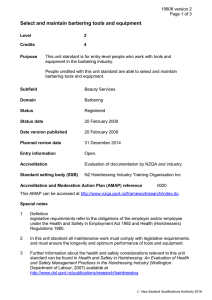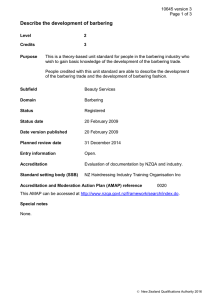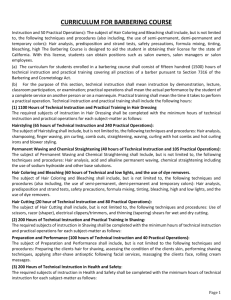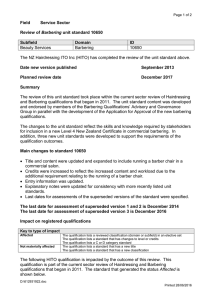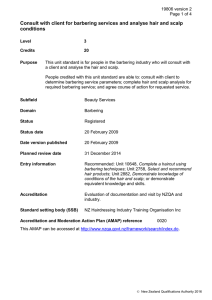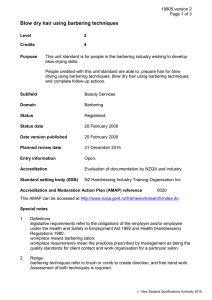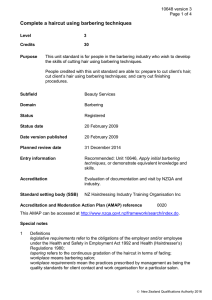BARBERING Apply barbering services under workplace conditions
advertisement
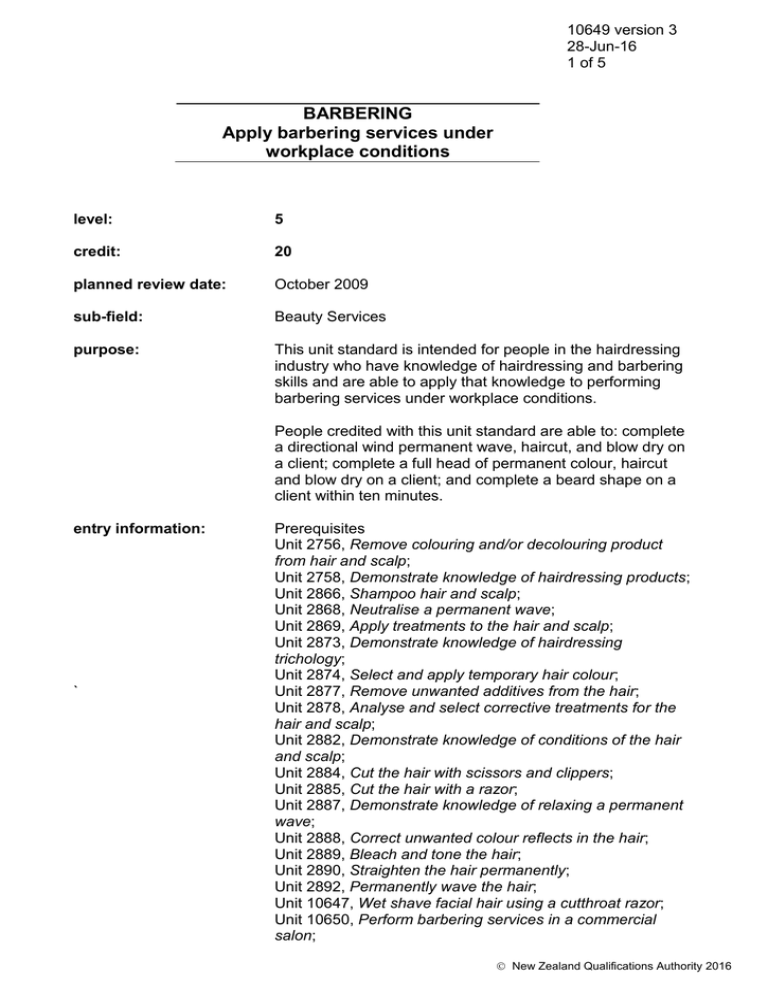
10649 version 3 28-Jun-16 1 of 5 BARBERING Apply barbering services under workplace conditions level: 5 credit: 20 planned review date: October 2009 sub-field: Beauty Services purpose: This unit standard is intended for people in the hairdressing industry who have knowledge of hairdressing and barbering skills and are able to apply that knowledge to performing barbering services under workplace conditions. People credited with this unit standard are able to: complete a directional wind permanent wave, haircut, and blow dry on a client; complete a full head of permanent colour, haircut and blow dry on a client; and complete a beard shape on a client within ten minutes. entry information: ` Prerequisites Unit 2756, Remove colouring and/or decolouring product from hair and scalp; Unit 2758, Demonstrate knowledge of hairdressing products; Unit 2866, Shampoo hair and scalp; Unit 2868, Neutralise a permanent wave; Unit 2869, Apply treatments to the hair and scalp; Unit 2873, Demonstrate knowledge of hairdressing trichology; Unit 2874, Select and apply temporary hair colour; Unit 2877, Remove unwanted additives from the hair; Unit 2878, Analyse and select corrective treatments for the hair and scalp; Unit 2882, Demonstrate knowledge of conditions of the hair and scalp; Unit 2884, Cut the hair with scissors and clippers; Unit 2885, Cut the hair with a razor; Unit 2887, Demonstrate knowledge of relaxing a permanent wave; Unit 2888, Correct unwanted colour reflects in the hair; Unit 2889, Bleach and tone the hair; Unit 2890, Straighten the hair permanently; Unit 2892, Permanently wave the hair; Unit 10647, Wet shave facial hair using a cutthroat razor; Unit 10650, Perform barbering services in a commercial salon; New Zealand Qualifications Authority 2016 10649 version 3 28-Jun-16 2 of 5 BARBERING Apply barbering services under workplace conditions Unit 12313, Highlight the hair using a weaving technique; Unit 17469, Demonstrate knowledge of the selection and application of semipermanent hair colour; Unit 19791, Select and apply midway hair colour; Unit 19792, Select and apply permanent hair colour; and Unit 19793, Highlight and/or lowlight using elementary techniques; or demonstrate equivalent knowledge and skills. accreditation option: Evaluation of documentation and visit by NZQA and industry. moderation option: A centrally established and directed external moderation system has been set up by the Hairdressing Industry Training Organisation. special notes: 1 It is a requirement of industry that assessment against this unit standard should take place within the context of the candidate seeking award for the National Certificate in Hairdressing with strands in Hairdressing Practice, and Barbering Practice [Ref: 0022], where the candidate is seeking award of the qualification with the Barbering Practice strand. It is also a requirement of industry that assessment against this unit standard should take place after the candidate has achieved the levels 1 to 4 unit standards (including those not cited above as prerequisites) that are listed in the Barbering Practice strand of the National Certificate in Hairdressing with strands in Hairdressing Practice, and Barbering Practice [Ref: 0022], or has demonstrated equivalent knowledge and skills. 2 In this unit standard all work must comply with legislative requirements and ensure optimum hair condition and maximum client comfort at all times. 3 Industry standards are listed in Hairdressing and Barbering Industry Standards at http://www.hito.org.nz. 4 Sanitisation of tools and equipment, and cleaning of the workstation occurs throughout the services performed according to legislative requirements. 5 To reflect commercially acceptable time evidence for all elements must be provided within a four hour time period. New Zealand Qualifications Authority 2016 10649 version 3 28-Jun-16 3 of 5 BARBERING Apply barbering services under workplace conditions 6 Definitions barbering techniques may include but are not limited to hair cutting techniques of nape shaping, line outs, freehand clipper and clipper guard work (no guard to four guard), scissor over comb, clipper over comb, razor, scissors, razor over comb, freehand clippers, and blow drying using freehand, cushion and vent brush work; commercially acceptable time is stipulated in the evidence guides to candidates provided by the Hairdressing Industry Training Organisation. Commercially acceptable time varies for different barbering services. Times reflect performance required for the economic viability of a trading salon; industry techniques are those stipulated in the evidence guides to candidates provided by the Hairdressing Industry Training Organisation; legislative requirements refer to industry and legislative requirements contained in: Sections 6 and 7 of the Health (Hairdressers) Regulations 1980; NZ Association of Hairdressers Inc., Guide to Occupational Safety and Health for the Hairdressing Industry (Auckland, 1997) available at http://www.osh.dol.govt.nz/order/catalogue/hairdressing industry.shtml; Material Safety Data Sheets (MSDSs); Privacy Act 1993, Health and Safety in Employment Act 1992, Human Rights Act 1993, Smoke-free Environments Act 1990, and subsequent amendments, Fire Safety and Evacuation of Buildings Regulations 1992, and enterprise fire and emergency policies and procedures. New Zealand Qualifications Authority 2016 10649 version 3 28-Jun-16 4 of 5 BARBERING Apply barbering services under workplace conditions Elements and Performance Criteria element 1 Complete a directional wind permanent wave, haircut, and blow dry on a client. performance criteria 1.1 Client’s needs are analysed and confirmed, and techniques and objectives relevant to these needs are determined and specified. 1.2 Chemical processes are conducted following industry techniques and manufacturer’s instructions. 1.3 Hair is cut using barbering techniques. 1.4 Hair is blow dried using barbering techniques. 1.5 Results meet the confirmed objectives. element 2 Complete a full head of permanent colour, haircut and blow dry on a client. Range: evidence gathered in relation to element 2 must be derived from a hairstyle and technique different from those used for element 1. performance criteria 2.1 Client’s needs are ascertained and confirmed, and techniques and objectives relevant to these needs are determined and specified. 2.2 Chemical processes are conducted following industry standards and manufacturer’s instructions. 2.3 Hair is cut using barbering techniques. 2.4 Hair is blow dried using barbering techniques. 2.5 Results meet the confirmed objectives. New Zealand Qualifications Authority 2016 10649 version 3 28-Jun-16 5 of 5 BARBERING Apply barbering services under workplace conditions element 3 Complete a beard shape on a client within ten minutes. performance criteria 3.1 Client’s needs are analysed and confirmed, and techniques and objectives relevant to these needs are determined and specified. 3.2 Beard is cut using barbering techniques. 3.3 Results meet the confirmed objectives. Comments on this unit standard Please contact NZ Hairdressing Industry Training Organisation enquiries@hito.org.nz if you wish to suggest changes to the content of this unit standard. Please Note Providers must be accredited by the Qualifications Authority or a delegated interinstitutional body before they can register credits from assessment against unit standards or deliver courses of study leading to that assessment. Industry Training Organisations must be accredited by the Qualifications Authority before they can register credits from assessment against unit standards. Accredited providers and Industry Training Organisations assessing against unit standards must engage with the moderation system that applies to those standards. Accreditation requirements and an outline of the moderation system that applies to this standard are outlined in the Accreditation and Moderation Action Plan (AMAP). The AMAP also includes useful information about special requirements for providers wishing to develop education and training programmes, such as minimum qualifications for tutors and assessors, and special resource requirements. This unit standard is covered by AMAP 0020 which can be accessed at http://www.nzqa.govt.nz/site/framework/search.html. New Zealand Qualifications Authority 2016
